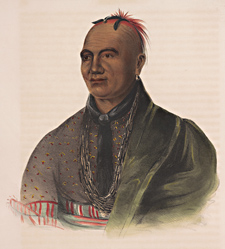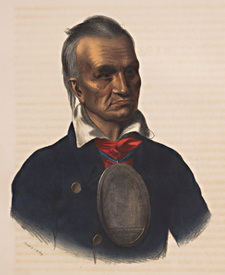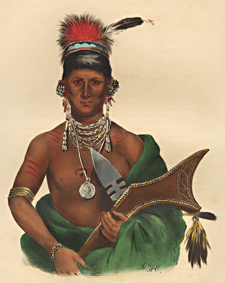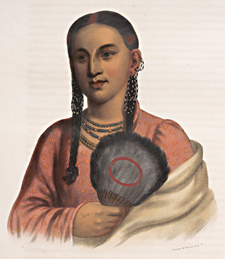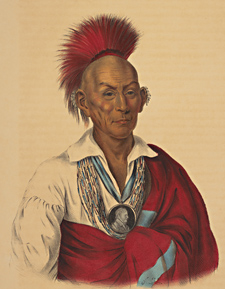
Vanished Worlds, Enduring People
Illustrated Works
Thomas McKenney
Thomas Loraine McKenney (1785-1859) began planning his grandiose, three-volume History of the Indian Tribes of North America while serving as Superintendent of the Bureau of Indian Affairs in Washington D. C. between 1816 and 1830. His administrative responsibilities brought him into frequent contact with the representatives of Indian tribes, many of whom traveled to the Capital to voice grievances or negotiate treaties.
Interested in learning more about his Native American visitors, McKenney began to acquire artifacts of their lives–robes, bows and arrows, moccasins, even a live elk. At the heart of his growing collection was a gallery of Indian portraits, which he commissioned from a local artist, Charles Bird King (1785-1862). King’s first portraits were of members of a Pawnee, Omaha, Kansa, Oto, and Missouri delegation, who arrived in Washington in the fall of 1821. Of the twenty-five paintings King executed that November, seventeen were given to members of the delegation and eight were deposited in McKenney’s gallery.
After his dismissal from the Indian Office in 1830, McKenney increased his efforts to publish his Indian gallery. King’s portraits formed the basis of what became a majestic series of 120 hand-colored lithographs accompanied by Indian biographies written by James Hall (1793-1868). The first number of the publication, a set of six lithographs, reached subscribers in early 1837. The twentieth and final number arrived in 1844. Charles Bird King’s original portrait gallery was transferred to the Smithsonian in 1858. It was almost entirely destroyed by fire in 1865, leaving McKenney and Hall’s History of the Indian Tribes of North America as its primary legacy.
Charles Bird King, “Black Hawk (Sauk),” from Thomas Loraine McKenney and James Hall. History of the Indian tribes of North America. Philadelphia: E. C. Biddle, 1836-1844. [view]
Black Hawk, a Sauk chief (ca. 1767-1838), was one of the last famous Native Americans to sit for a portrait by Charles Bird King (1765-1862) for McKenney and Hall’s History. During the 1832 Black Hawk War, he unsuccessfully resisted the occupation of Sauk villages and farms in Illinois by white settlers. He was an object of much curiosity in 1837 when he visited Washington with his former rival, Keokuk, and his delegation. Today, the Sauk are part of the Sac and Fox Nation in Oklahoma.
Charles Bird King, “Joseph Brant (Mohawk),” from Thomas Loraine McKenney and James Hall. History of the Indian tribes of North America. Philadelphia: E. C. Biddle, 1836-1844. [view]
Charles Bird King, “Red Jacket (?),” from Thomas Loraine McKenney and James Hall. History of the Indian tribes of North America. Philadelphia: E. C. Biddle, 1836-1844. [view]
Charles Bird King, “Appanoose (Sauk),” from Thomas Loraine McKenney and James Hall. History of the Indian tribes of North America. Philadelphia: E. C. Biddle, 1836-1844. [view]
Charles Bird King, “Flying Pigeon (Ioway),” from Thomas Loraine McKenney and James Hall. History of the Indian tribes of North America. Philadelphia: E. C. Biddle, 1836-1844. [view]
